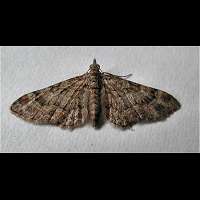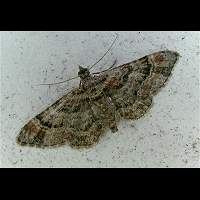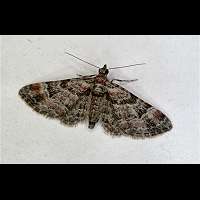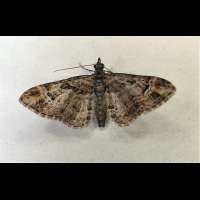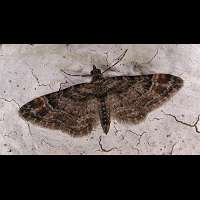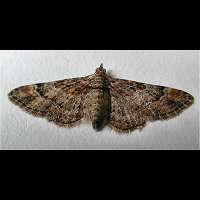Double-striped Pug (Gymnoscelis rufifasciata)
This Moth is also known as the Olive Moth and the Haworth Moth.
The Double-striped Pug is easily identified. The wings show a few reddish brown patches or are reddish brown entirely. In most other pugs the basic colour is either grey or greyish brown. Then there is the double stripe mentioned in the name of the moth. Yet there are less strikingly marked specimens about and this species soon looses much of its freshness, making it much more obscure. Especially the summer generation usually is quite small and less well marked. The animal in the fourth picture from the top belongs to the summer generation. The Double-striped Pug is very variable anyway. In doubt always look at the wings, for these are extremely pointed. It has no real look-a-likes, so usually it isn't very difficult to name it. The wingspan varies very much as well: from 14 to 20 mm.
The caterpillar is just as variable as the adults are. The basic colour may be white, yellowish green, or reddish brown or even almost black. The best identifier is seen on the back: a number of clearly shaped blackish V-markings. The head is yellowish brown. The larvae eventually will reach a length of some 17 mm. The moths of the first generation will lay their eggs in May. The larvae grow quickly and will pupate in June. The second generation will be present in July. The pupa overwinters. The caterpillar of the Olive Moth is found on a great number of shrubs and lower plants, such as holly, gorse, wild and cultivated heather, ragwort etc. The larvae don't usually eat the leaves, but prefer flowers and fruits.
In (Northern) Scotland the Double-striped Pug has one generation only, on the wing in June and July. In most other parts of Britain two generations appear: the first in April and May and the second in July and August. In Southern England sometimes 3 generations appear, the third flying about in September and October. On the continent even more generations are produced. The animal starts flying in the late afternoon and usually settles before midnight. It is however also observed flying in sunshine. It is easily disturbed resting in bushes. Attracted to light in very small numbers only. A very common species in Europe, including all of the British Isles, often appearing in great numbers.
This Moth is also known as the Olive Moth and the Haworth Moth.
The Double-striped Pug is easily identified. The wings show a few reddish brown patches or are reddish brown entirely. In most other pugs the basic colour is either grey or greyish brown. Then there is the double stripe mentioned in the name of the moth. Yet there are less strikingly marked specimens about and this species soon looses much of its freshness, making it much more obscure. Especially the summer generation usually is quite small and less well marked. The animal in the fourth picture from the top belongs to the summer generation. The Double-striped Pug is very variable anyway. In doubt always look at the wings, for these are extremely pointed. It has no real look-a-likes, so usually it isn't very difficult to name it. The wingspan varies very much as well: from 14 to 20 mm.
The caterpillar is just as variable as the adults are. The basic colour may be white, yellowish green, or reddish brown or even almost black. The best identifier is seen on the back: a number of clearly shaped blackish V-markings. The head is yellowish brown. The larvae eventually will reach a length of some 17 mm. The moths of the first generation will lay their eggs in May. The larvae grow quickly and will pupate in June. The second generation will be present in July. The pupa overwinters. The caterpillar of the Olive Moth is found on a great number of shrubs and lower plants, such as holly, gorse, wild and cultivated heather, ragwort etc. The larvae don't usually eat the leaves, but prefer flowers and fruits.
In (Northern) Scotland the Double-striped Pug has one generation only, on the wing in June and July. In most other parts of Britain two generations appear: the first in April and May and the second in July and August. In Southern England sometimes 3 generations appear, the third flying about in September and October. On the continent even more generations are produced. The animal starts flying in the late afternoon and usually settles before midnight. It is however also observed flying in sunshine. It is easily disturbed resting in bushes. Attracted to light in very small numbers only. A very common species in Europe, including all of the British Isles, often appearing in great numbers.

